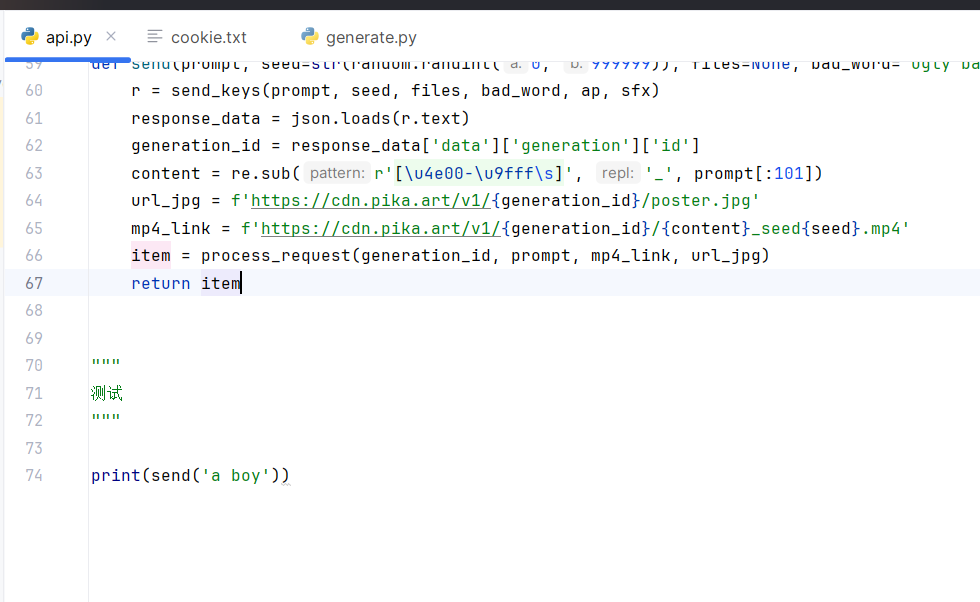环境为python3.x,依赖版本适配python3即可
项目目录
│ api.py //对外接口,项目启动器
│ cookie.txt //你的账号cookie
│ generate.py //发送视频生成请求
│ authorization.txt //账号token
└─static //下载后的视频存储部署
- 先将本项目pika下载到本地
- 在cookie.txt填写你的账号的cookie,在authorization.txt填写token
- 到api.py下发送请求
参生后的数据为一个falsk本地请求连接用于访问,自己部署falsk项目,端口为8081
本地存储在static目录下
环境为python3.7以上,依赖版本适配python3.7以上即可
部署
- 先将本项目chatgpt下载到本地
- 在cookie.txt填写你的账号的cookie,在authorization.txt填写token
- 到api.py下发送请求,此项目为flask项目
@app.route('/createId',methods=['GET'])
def createId():
conversation_id = make_new_conversation_id()
return jsonify({'id': conversation_id})这个是新建一个会话,返回这个唯一标识id,后面的通话就是靠这个id标识,可以创建多个
@app.route('/send', methods=['POST'])
def send():
conversation_id = request.json.get('conversation_id')
msg = request.json.get('msg')
ws = sends(msg, conversation_id)
return jsonify({'ws': ws})这是发送消息,用前面返回的id获取,然后返回一个websocket的url通道用于接收消息,由于这个不是很稳定,所以每次前端接收一个url就要创建一个连接,接收完后断开连接,这个websocket通道没有被墙国内可接收,但是发送需要魔法
以下是前端代码,vue3为例
- 创建新的会话id
function frist_(){
fetch('http://localhost:8081/createId').then(response => {
return response.json();
}).then(data => {
console.log(data.id); //返回的就是id
})
}- 发送消息
import base64 from 'base-64';
const fullMessage = ref([]);
//处理websocket所接收的信息,这个逻辑还得优化一下
function processMessage(message) {
const bodyStartIndex = message.indexOf('"body": "') + '"body": "'.length;
const bodyEndIndex = message.indexOf('", "more_body":');
const bodyContent = message.substring(bodyStartIndex, bodyEndIndex);
const decodedBody = base64.decode(bodyContent);
fullMessage.value.push(decodedBody);
if (decodedBody.includes('[DONE]')) {
try {
const parsedData = JSON.parse(fullMessage.value[fullMessage.value.length - 2].substring(6));
const partsValue = parsedData.message.content.parts[0];
console.log(partsValue); //解析的message也就是chatgpt所返回的消息
connectWebSocket.close()
} catch (e) {
console.log(e);
}
}
}
//连接websocket接收消息
const connectWebSocket = (ws) => {
const websocket = new WebSocket(ws);
websocket.onopen = () => {
console.log('Connected to WebSocket server');
};
websocket.onmessage = (event) => {
processMessage(event.data);
};
websocket.onerror = (error) => {
console.error('WebSocket encountered error: ', error);
};
websocket.onclose = () => {
console.log('WebSocket connection closed');
};
return websocket;
};
//发送消息
function sendMessage() {
fetch('http://localhost:8081/send', {
method: 'POST',
headers: {
'Content-Type': 'application/json'
},
body: JSON.stringify({ 'msg': ’发送的消息‘, 'conversation_id': ’frist_()所产生id' })
}).then(response => {
return response.json();
}).then(data => {
connectWebSocket(data.ws) //接收wss_url然后创建websocket通道接收消息
})
}国内用户需要魔法代理
有什么bug欢迎issues,或者加入本群930770787
The environment is python3.x, and the dependency version can be adapted to python3
Project directory
│ api.py // External interface, project launcher
│ cookie.txt // Your account cookie
│ generate.py //Send a video generation request
│ authorization.txt //Your account authorization
└─static //Video storage after downloadDeployment
- Download the pika of the project to your local computer
- Fill in the cookie of your account in the cookie.txt and the token in the authorization.txt
- Send the request under the test to the api.py
the data after the birth is a FALSK local request connection for access, and you can deploy the FALSK project yourself , and port is 8081
stored locally in the static directory
The environment is Python 3.7 or later, and the version can be adapted to Python 3.7 or later
Deployment
- Download the ChatGPT of this project to your local computer first
- Fill in the cookie of your account in the cookie.txt and the token in the authorization.txt
- Send a request to the api.py, which is a flask project
@app.route('/createId',methods=['GET'])
def createId():
conversation_id = make_new_conversation_id()
return jsonify({'id': conversation_id})This is to create a new session and return this unique identifier ID, and the subsequent calls can be identified by this ID, and multiple can be created
@app.route('/send', methods=['POST'])
def send():
conversation_id = request.json.get('conversation_id')
msg = request.json.get('msg')
ws = sends(msg, conversation_id)
return jsonify({'ws': ws})This is to send a message, get it with the id returned earlier, and then return a websocket URL channel for receiving messages, because this is not very stable, so every time the front-end receives a URL, it has to create a connection, and disconnect after receiving it
Here's the front-end code, Vue3 as an example
- Create a new session ID
function frist_(){
fetch('http://localhost:8081/createId').then(response => {
return response.json();
}).then(data => {
console.log(data.id); //The returned is the ID
})
}- Send messages
import base64 from 'base-64';
const fullMessage = ref([]);
//To handle the information received by the websocket, this logic needs to be //optimized
function processMessage(message) {
const bodyStartIndex = message.indexOf('"body": "') + '"body": "'.length;
const bodyEndIndex = message.indexOf('", "more_body":');
const bodyContent = message.substring(bodyStartIndex, bodyEndIndex);
const decodedBody = base64.decode(bodyContent);
fullMessage.value.push(decodedBody);
if (decodedBody.includes('[DONE]')) {
try {
const parsedData = JSON.parse(fullMessage.value[fullMessage.value.length - 2].substring(6));
const partsValue = parsedData.message.content.parts[0];
console.log(partsValue); //The parsed message is the message returned by ChatGPT
connectWebSocket.close()
} catch (e) {
console.log(e);
}
}
}
//Connect to a websocket to receive messages
const connectWebSocket = (ws) => {
const websocket = new WebSocket(ws);
websocket.onopen = () => {
console.log('Connected to WebSocket server');
};
websocket.onmessage = (event) => {
processMessage(event.data);
};
websocket.onerror = (error) => {
console.error('WebSocket encountered error: ', error);
};
websocket.onclose = () => {
console.log('WebSocket connection closed');
};
return websocket;
};
//Send a message
function sendMessage() {
fetch('http://localhost:8081/send', {
method: 'POST',
headers: {
'Content-Type': 'application/json'
},
body: JSON.stringify({ 'msg': 'Send a message', 'conversation_id': 'the id' })
}).then(response => {
return response.json();
}).then(data => {
connectWebSocket(data.ws) //Receive wss_url then create a websocket channel to receive messages
})
}

